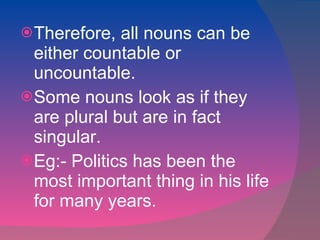English ppt
- 2. What is a subject? - The subject of a sentence is the person, place, thing, or idea that is doing or being something . Examples - Builders are at work. - The large car stopped outside our house.
- 3. A subject can be- 1 . Singular e.g. a pen, a body, a box 2. Plural e.g. children, plates, boxes 3. Uncountable e.g. furniture , sugar
- 4. What is a verb? A verb is a word which describes the action in a sentence (the doing word) Examples - I play football. - They skip quickly. - We eat spaghetti. - Bob is seven today .
- 5. Therefore, all nouns can be either countable or uncountable. Some nouns look as if they are plural but are in fact singular. Eg:- Politics has been the most important thing in his life for many years.
- 6. Verbs can be either singular or plural . SINGULAR VERB Eg:- Acoustics is the study of the behavior of sound. PLURAL VERB Eg:- The acoustics in this hall are terrible .
- 7. Subject-Verb Agreement Subjects and verbs must AGREE with one another in number (singular or plural). Thus, if a subject is singular, its verb must also be singular; if a subject is plural, its verb must also be plural. In present tenses, nouns and verbs form plurals in opposite ways: nouns ADD an s to the singular form, BUT verbs REMOVE an s from the singular form.
- 8. By Soundarya Mythri Preyasha Ashwin








